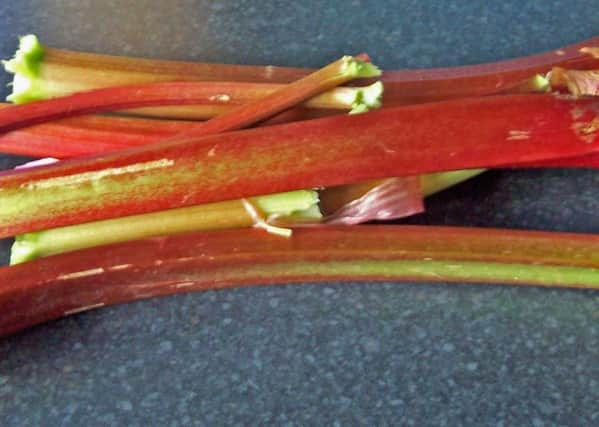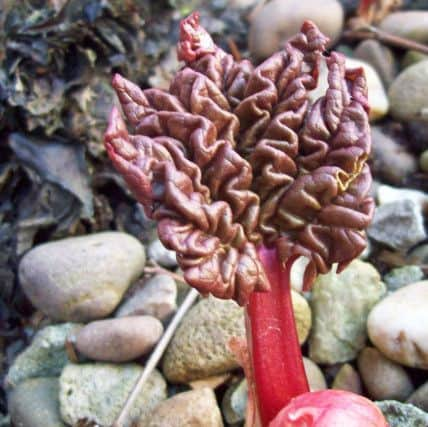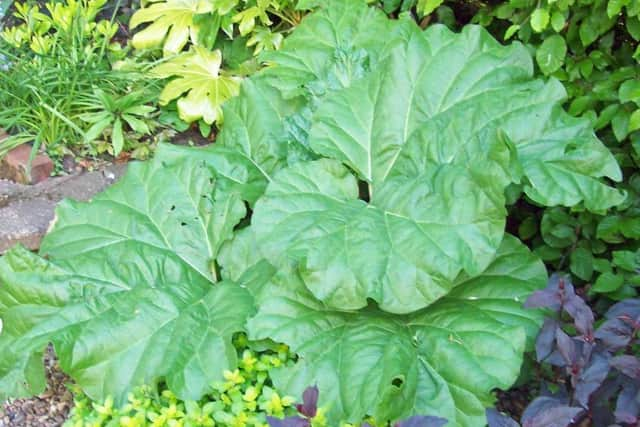GARDENING: Prepare to be patient when growing rhubarb


Pot-grown rhubarb can be planted at any time, in an open, sunny site with free-draining soil. With crowns, plant late autumn-early winter. Space plants 75-90cm (30-36in) apart, with 30cm (12in) between rows.
If you can’t wait until April for your first crops, try forcing an established plant. In January, cover the crown with straw and place a large bucket over the top to exclude light.


Advertisement
Hide AdAdvertisement
Hide AdThe pale pink, tender stems can be harvested about eight weeks after covering. Don’t force the same crown for two years in a row, as it weakens the plant.
If you planted new crowns in autumn, don’t harvest during the first year. Remove a few stems the next year, then up to a third or half from then on.
It’s best to stop cropping by June (unless you have an autumn-cropping cultivar), or at least only remove a few stalks after then – older varieties ofter go stringy then anyway and the plant needs the sustenance.
Keep rhubarb free of weeds by mulching with composted manure, but avoid burying the crown as it will rot. Give plants 100g per sq m of Growmore in March and water regularly in dry spells.


Advertisement
Hide AdAdvertisement
Hide AdWhen the top growth dies back in autumn, remove the dead leaves to expose the crown to frost – this will ensure a good crop the following year.
A word of warning – only the stems of rhubarb are edible.
The leaves contain toxic oxalic acid – cut off the leaves and add them to your compost heap.
RECOMMENDED VARIETIES


Timperley Early: Thick stems, early, high yield. Bred for forcing; performs very well outside, but even better colour when forced.
Victoria: Late type with heavy yields.
Hawke’s Champagne: Compact plants with high yield potential. It has attractive, bright red, medium length, uniform stems.
Livingstone: Autumn crop, September to November.


JOBS FOR THE WEEKEND
Advertisement
Hide AdAdvertisement
Hide AdPrune late summer-flowering clematis. To keep your clematis small and to rejuvenate old plants, cut back hard to about a foot off the ground. If you want to keep them taller, just prune last year’s flowered shoots.
Clear borders of wind-blown debris, dig out any leftover annuals and if they are really annoying you, cut herbaceous perennials down to their crowns. Look out for rotting on died-down perennials.
Clear alpine beds of debris and cover bare patches with gritty compost. Remove weeds before mulching in spring.
Keep containers tidy, cutting back and removing dead leaves. Mulch with grit - it looks good and reduces surface puddling after heavy rain.
Advertisement
Hide AdAdvertisement
Hide AdWatch out for downy mildew and black spot on winter pansies. Remove infected leaves and destroy badly affected plants.
Prune Wisteria – cut back sideshoots shortened by summer pruning to two or three buds. Don’t cut off flower buds!
Ornamental vines, ivy, Virginia creeper and Boston ivy can be cut back now – keep them away from windows, doors, gutters and roof tiles.
Coral spot is often noticed on twigs from deciduous hedges, shrubs and trees, connected with poor ventilation and congested, twiggy growth inside clipped hedges.
Advertisement
Hide AdAdvertisement
Hide AdCacti need very little water, and no feeding, during winter. Keep them barely moist until spring.
If the weather is mild you can lay a new turf or repair an existing lawn. Repair lawn edges with turves cut from other areas.
GET IN TOUCH
For more on these topics, plus cook what you grow, traditional recipes, North East information, environmental news and more, log on to www.mandycanudigit.com (now smartphone friendly), www.sunderlandecho.com/gardening, follow me on Twitter @MandyCanUDigIt or you can like me on Facebook at Mandycanudigit